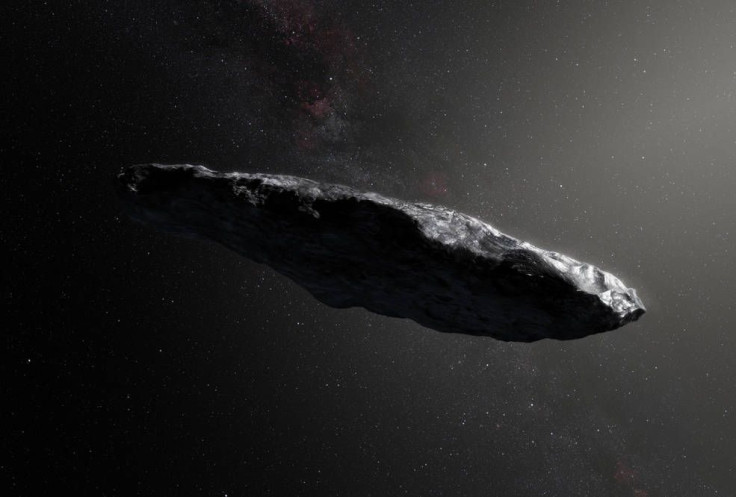Alien Origin Not Ruled Out For Mysterious Interstellar Object 'Oumuamua, Study Suggests
KEY POINTS
- 'Oumuamua could still be alien tech, astrophysicists Avi Loeb and Thiem Hoang suggest
- Their paper contradicted a hypothesis that the object is a comet being propelled by hydrogen blasting off its surface
- The scientists said starlight would prevent solid hydrogen chunks from forming a body as large as 'Oumuamua's
Interstellar visitor 'Oumuamua may still be the work of an advanced alien race despite most scientists leaning more toward non-extraterrestrial explanations for its accelerating movement, a new study suggests.
First spotted by astronomers in October 2017, astronomers were baffled by the first known interstellar object to enter the solar system. Close observations of 'Oumuamua, which left the solar system last year, revealed that it resembled a cigar with its long and thin appearance and appeared to be accelerating despite having no visible tail like a comet.
In a new paper published Aug. 17 in The Astrophysical Journal Letters, Harvard University astrophysicist Avi Loeb and Thiem Hoang, an astrophysicist at the Korea Astronomy and Space Science Institute, contradicted the hypothesis that hydrogen is blasting off 'Oumuamua's surface and propelling it forward.
This explanation came from astrophysicists Darryl Seligman and Gregory Laughlin's June 9 paper, which suggested that the space rock was a comet partly or entirely made up of molecular hydrogen. Like a comet, when 'Oumuamua approached the sun, the ice on its surface turns to gas, causing it to speed up. This process would not be visible from Earth, thus explaining the absence of a comet tail.
Loeb and Hoang, however, argued that it is unlikely that a "hydrogen iceberg" the size of 'Oumuamua would be able to form as starlight would warm up solid chunks of hydrogen before they can clump together.
The researchers also said a hydrogen iceberg would not be able to survive a trip from the nearest "giant molecular cloud" — a dusty, gassy region of space where these objects are thought to form. The "comet" would have long fallen apart in the hundreds of millions of years it would take to travel through space.
Seligman agreed with Loeb's analysis that a hydrogen comet would not be able to survive such a trip, Live Science reported. He said his own hypothesis applies only if 'Oumuamua is 40 million years old.

"Hydrogen icebergs don't live that long in the galaxy," he said. "And you definitely don't have time to get all the way from [the nearest] giant molecular cloud."
As for what he believes is the most likely explanation for 'Oumuamua's bizarre acceleration, Loeb suggested that his upcoming book, "Extraterrestrial: The First Sign of Intelligent Life Beyond Earth," will have the answers. It is set to be released in January.
Back in 2018, Loeb, the chair of Harvard’s Astronomy Department, proposed in a paper he co-authored with postdoctoral fellow Shmuel Bialy that 'Oumuamua may be an alien-made lightsail propelled by either solar radiation or lasers.
“When I first heard about ‘Oumuamua, this idea was in the back of my mind,” Loeb said in a statement. “So I approached Shmuel and said, ‘Let’s see whether sunlight can push this’ … because there was nothing else I could think of which could account for our observations, because this object is weird. So, my approach was to follow the maxim of Sherlock Homes — ‘When you have excluded the impossible, whatever remains, however improbable, must be the truth.’”
© Copyright IBTimes 2024. All rights reserved.






















